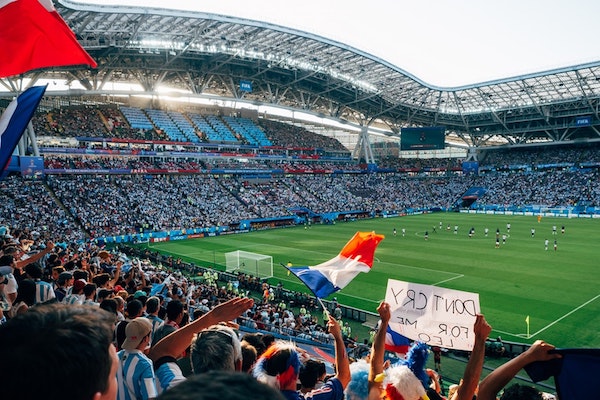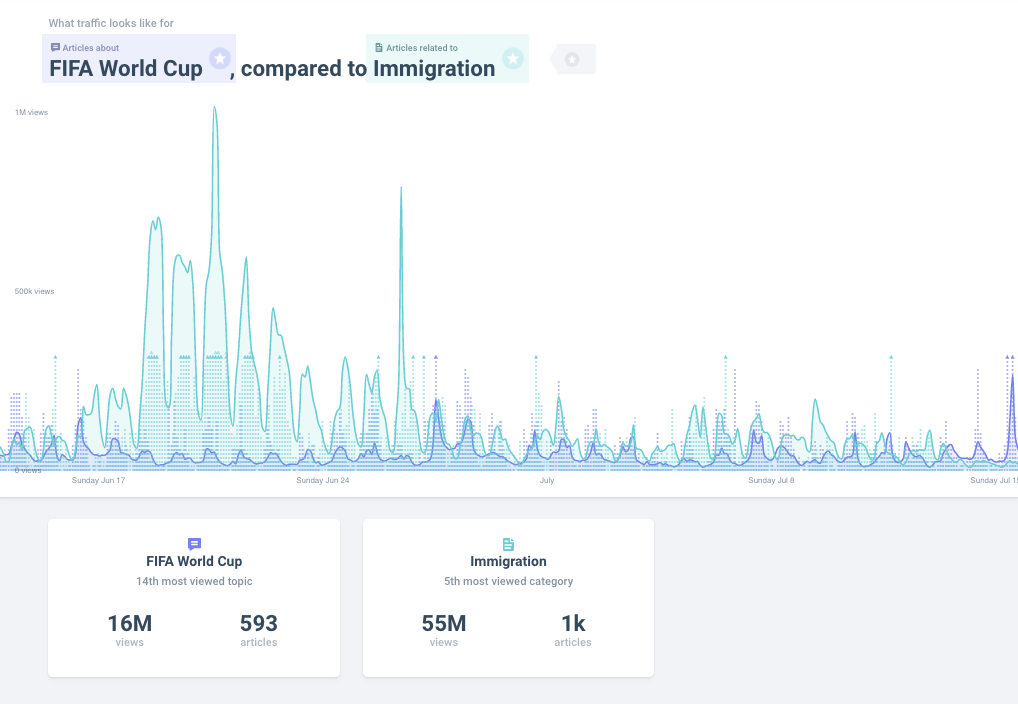GOOOOAAALLLLL: Scoring online attention of World Cup audiences

Were you out in the bars celebrating when France won the finals over Croatia? Or were you mystified by the obsessive behavior of people you had no idea were soccer fans?
Whatever your level of interest, there’s a good chance the 2018 FIFA World Cup fell somewhere on your radar between June 14 and July 15. Based on data from Currents the World Cup was the 14th most viewed topic during the tournament’s duration, with 16 million total views and almost 600 articles on the subject.
What was driving attention for the World Cup? Turns out, it wasn’t always the teams that won (désolée, Les Bleus) but it was usually through Google search. The month-long tournament also had to compete for fans’ attention with sports and national news.
Here’s what the data has to say about the teams fans cared about, how readers were finding World Cup updates, and how attention for soccer compared to other sports and political news.
4-2 France, but Croatia won the attention
France may have beat Croatia on the 15th, but Croatia enthralled readers more. For the week leading up to the finals, there were three times as many page views to articles about Croatia than about France (3 million vs. 1 million).

It seems the best stories weren’t always about the team taking home the trophy. Even when teams got knocked out of the tournament they still beat France for attention. Russia and Brazil both lost in the quarter-finals, but look at how much attention they continued to receive:

France and Brazil had the same number of articles views from the time of the semi-finals to the finals. Russia had twice as many. It wasn’t until France won the tournament on the 15th that attention for the champions finally eclipsed that of the other teams.
70% of traffic to the World Cup was on mobile during the semi-finals and the finals
Imagine you’re in a bar watching the France vs. Croatia game. When the crowd around you isn’t focused on the TV, shouting about a play, or consulting the menu, where’s their gaze?
Short answer: on their phones. The levels of attention for different teams varied but Google search dominated across topics as a primary referral source. People Googled articles about France and the FIFA World Cup more than twice as often as they found them on social media.
Nearly 70% of traffic to France, Croatia, and the World Cup was on mobile during the semi-finals and the finals. Many of the related topics to these stories were players, including Didier Deschamps, Paul Pogba, Antoine Griezmann, and Zinedine Zidane. Put these two facts together and it’s clear people are on their phones during commercial breaks asking: Who’s starting for France? Was that really offsides? When did Zidane headbutt that guy? Who is Didier Deschamps?

This differed for a breaking news topic during the game. For instance, attention to articles about Pussy Riot were heavily found through social sources, even though it was the top Google search query.
The attention Grand Slam: 15 – love, tennis
The World Cup wasn’t happening in a sports vacuum. When France played Croatia in the finals on July 15th, there was another big tournament that got four times as many views at the World Cup: the 2018 Wimbledon Championships. For a few hours that Sunday morning, when Novak Djokovic defeated Kevin Anderson and Angelique Kerber defeated Serena Williams, Wimbledon served more eyeballs than the World Cup.
But what about the long-haul? The World Cup is a month-long tournament while Wimbledon is only the first two weeks of July. Here’s how attention for soccer compared to tennis over the entire duration of the World Cup:

Soccer had high search traffic, but tennis had it beat: 54% of traffic to the Wimbledon Championships came from search, compared to 47% for the World Cup.
Where soccer outpaced tennis was in social media traffic and editorial promotion (homepages, section pages, and clicking around links within sites). The World Cup had three times as much attention on social than tennis. There were twice as many articles written about the World Cup and soccer was more likely to see traffic through editorial promotion..
When it comes to coverage, the length of the tournament played in FIFA’s favor: there was more to write about and more time to write it. Seeing the spike in attention for Wimbledon when the tournament started on July 1 raises an interesting question for sports writers and marketers: How can you get fans excited about the tournament even before it begins?
Sports in the context of national news: small moments of celebration
In our network, politics consistently drew more attention than the World Cup. Take immigration, for example, a topic that dominated the national conversation starting in June. Any surges in attention for the tournament were brief before politics took center stage once more.

Still, it’s worth noting the moments when soccer eclipsed politics stories in terms of attention, such as on June 27th when Brazil played Serbia and during the final match on July 15th. Moments like those embody the beauty of the World Cup, as Tom Philip argues in a New York Times opinion piece:
“The World Cup…is also colorful, joyful, downright good television and, in the grand scheme of things, not all that important. This is not an insult. It’s an ode. At a time when seven out of 10 Americans admit they are worn out by the high-stakes anxiety of the news, this summer’s tournament couldn’t have come at a better time.”
That being said, the World Cup and politics—and even immigration—weren’t always distinct topics, and moments when they intertwined are worth celebrating, too. Two-thirds of the players on the winning team came from immigrant backgrounds, France 24 reports. Midfielder Blaise Matuidi said, “The diversity of the squad is in the image of this beautiful country that is France.”
So if the World Cup held your attention this summer, even for a moment, hopefully you enjoyed the respite.